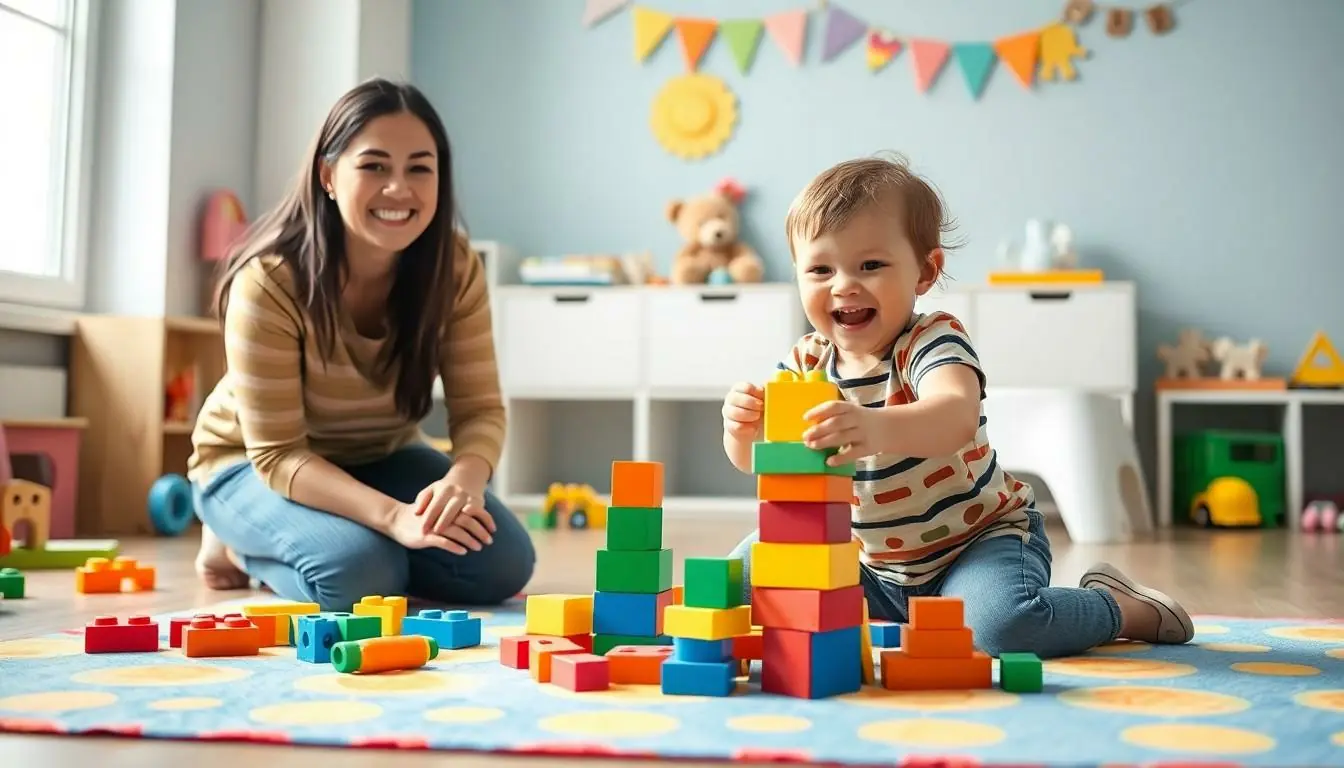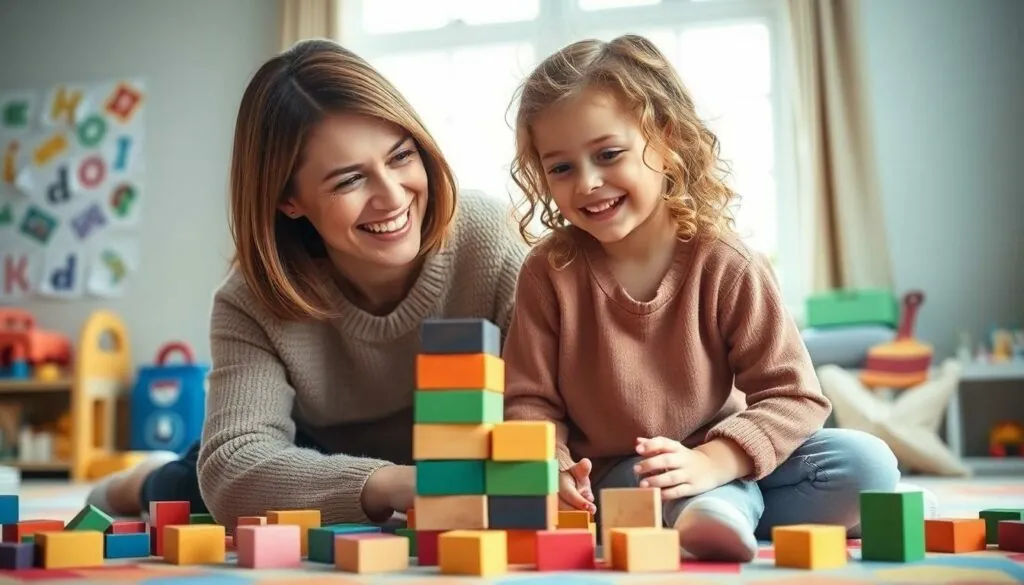Table of Contents
ToggleNavigating the wild world of toddler parenting can feel like trying to herd cats—adorable, chaotic, and full of surprises. One moment, they’re giggling over a stuffed animal, and the next, they’re launching a full-scale revolt over a bowl of broccoli. It’s a rollercoaster ride that leaves parents breathless and occasionally questioning their sanity.
Understanding Toddler Development
Understanding toddler development involves recognizing the rapid changes toddlers experience. These stages shape their physical, emotional, and cognitive abilities.
Key Milestones
Key milestones in toddler development include walking, talking, and social interaction. At around 12 months, many toddlers begin to take their first steps. By 18 months, they often say several words and may point to objects of interest. Socially, they start engaging in parallel play with peers. By age 2, many children can form simple sentences and exhibit increased independence. Parents can track these milestones to spot both healthy development and any areas needing attention.
Emotional Growth
Emotional growth plays a crucial role in a toddler’s overall development. During these early years, toddlers often experience strong emotions like joy, frustration, and fear. They begin to develop empathy, sometimes showing concern for others in distress. By age 2, toddlers may display possessiveness over toys, highlighting their understanding of sharing and boundaries. Encouraging them to express their feelings supports healthy emotional expression. Parents should model appropriate responses, facilitating emotional intelligence in their toddlers.
Effective Communication Techniques
Effective communication plays a crucial role in toddler parenting. Utilizing the right techniques can foster understanding and strengthen the parent-child bond.
Active Listening
Active listening involves fully focusing on a child’s words and emotions. Parents can establish eye contact to show engagement. Encouraging children to express themselves naturally enhances communication. Pausing before responding gives them time to think. Reflecting back what they say helps validate their feelings. Understanding a toddler’s non-verbal cues, such as gestures and facial expressions, is equally important. Children appreciate when adults listen intently. Building this skill early promotes confidence in sharing thoughts.
Encouraging Expression
Encouraging expression supports toddlers’ emotional development. Providing a safe space for feelings is essential. Parents can use open-ended questions to stimulate conversation. For example, asking “What do you think about that?” invites sharing. Offering various ways to express emotions, such as through art or play, enriches their understanding. Celebrating their unique expressions fosters creativity. Modeling emotional language helps toddlers learn to articulate feelings effectively. These practices build a foundation for strong communication skills.
Positive Discipline Strategies
Implementing positive discipline strategies helps parents guide toddlers effectively. These approaches focus on nurturing a child’s development while setting clear expectations.
Setting Boundaries
Establishing clear boundaries is essential in toddler parenting. Parents create a safe environment by outlining acceptable behaviors and consequences. Consistency in enforcing these boundaries fosters security. Toddlers thrive when they know what to expect, making daily routines crucial. Provide choices within those boundaries to encourage independence. For example, letting children choose between two outfits empowers decision-making skills. Reinforcement through praise when a child adheres to boundaries strengthens positive behavior.
Time-Out Techniques
Using time-out techniques offers a constructive way to address inappropriate behavior. Parents can implement a brief time-out in a designated calm area. This space should be free from distractions to help children reflect. Time-outs lasting one minute per year of age promote age-appropriate understanding. Explain the reason for the time-out to clarify expectations. Avoid using time-out as a punishment; instead, frame it as a moment to regroup. Reinforcing positive behavior post-time-out helps toddlers learn effective emotional regulation.
Building a Routine
Establishing a routine creates a sense of stability for toddlers. Regular activities help them understand expectations, fostering security and reducing anxiety.
Importance of Consistency
Consistency plays a crucial role in toddler routines. Predictable schedules enhance a child’s understanding of time. It allows them to anticipate daily events, such as meals and naps. For instance, a toddler may thrive with a set bedtime, making it easier for them to fall asleep. Familiarity with routines builds trust and comfort, aiding emotional development. Consistent responses to behavior also help toddlers learn acceptable boundaries. Routines should remain adaptable but maintain core elements for effective behavioral guidance.
Incorporating Flexibility
Flexibility helps accommodate the unpredictable nature of toddler behavior. While routines establish stability, unexpected situations, such as illness or family events, may arise. A capable parent adjusts activities while maintaining the overall structure, ensuring toddlers remain comfortable. Integrating small changes, like varying mealtimes or activity locations, keeps routines from feeling rigid. It fosters adaptability in young children, preparing them for changes in life. Encouraging input from toddlers enhances their sense of ownership and investment in routines. Flexibility ensures that daily activities remain engaging and supportive of a toddler’s developing needs.
Engaging Activities for Toddlers
Engaging activities for toddlers stimulate creativity, encourage exploration, and foster learning through play. Parents can incorporate a variety of options to keep their little ones entertained.
Indoor Play Ideas
Indoor activities can enhance fine motor skills and spark imagination. Art projects using non-toxic crayons promote creativity. Building blocks support spatial awareness and encourage problem-solving. Simple baking tasks allow toddlers to participate in measuring and stirring, enhancing their understanding of concepts like volume and temperature. Playing with toy instruments boosts rhythm recognition and auditory skills. Storytime with interactive elements keeps toddlers engaged and improves language development. Each of these activities not only entertains but also integrates learning experiences seamlessly into daily routines.
Outdoor Exploration
Outdoor exploration offers rich opportunities for sensory experiences and physical activity. Nature walks encourage curiosity about the environment, helping toddlers observe plants and animals. Playing in the sand builds fine motor skills through digging and pouring. Gardening allows toddlers to engage with nature hands-on, teaching them about responsibility and patience. Playground visits offer physical challenges, enhancing coordination and balance. Bubbles provide visual stimulation while promoting active play as toddlers chase and pop them. These experiences foster a connection to nature, encouraging healthy development in early childhood.
Conclusion
Toddler parenting is a journey filled with ups and downs that can be both rewarding and challenging. By understanding developmental milestones and employing effective communication techniques, parents can nurture their child’s emotional and cognitive growth. Positive discipline strategies and consistent routines provide a framework that fosters security and independence.
Incorporating engaging activities into daily life not only stimulates creativity but also promotes essential skills. Embracing the chaos while maintaining flexibility allows parents to adapt to their toddler’s ever-changing needs. With patience and love, parents can navigate this exciting phase of life, fostering a strong foundation for their child’s future.





